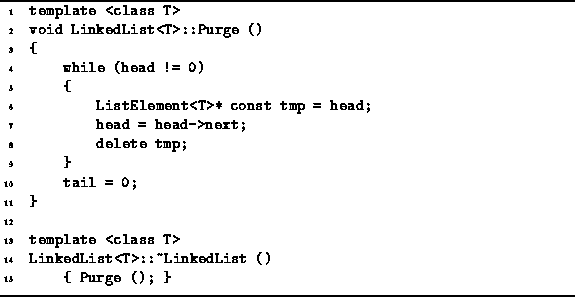Program ![]() gives the code
for the destructor and the Purge member function
of the LinkedList<T> class.
In the general case,
when the destructor is invoked,
we cannot expect the list to be empty.
Therefore, it is the responsibility of the destructor
to first release any ListElement<T>s
which have been allocated and linked into the list.
And this is precisely what the Purge member function does.
gives the code
for the destructor and the Purge member function
of the LinkedList<T> class.
In the general case,
when the destructor is invoked,
we cannot expect the list to be empty.
Therefore, it is the responsibility of the destructor
to first release any ListElement<T>s
which have been allocated and linked into the list.
And this is precisely what the Purge member function does.

Program: LinkedList<T> Class Destructor and Purge Member Function Definitions
The main loop of the Purge function simply traverses all the elements of linked list, deleting each of them one-by-one. Note that the body of the loop has been carefully written so as to determine the new value of head, before deleting the current list element. E.g., the following loop body is the wrong way to do it:
while (head != 0)
{
delete head;
head = head->next; // Wrong. Don't do this.
}
The problem with the code fragment above is that
the head pointer is dereferenced after the object to
which it points has been deleted.
While this code might actually work fortuitously for some compilers
on some machines under some operating systems,
it is invalid and illegal.